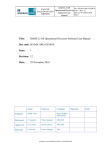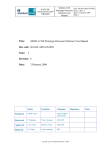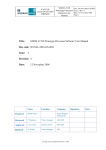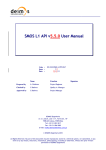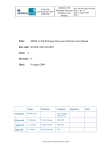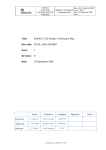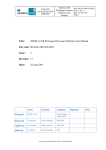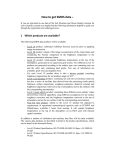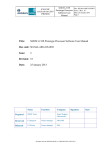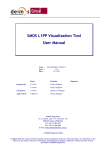Download SO-TP-ARG-GS-0025 Issue
Transcript
ACRI-ST ICM-CSIC LOCEAN/SA/CETP IFREMER Title: Software Verification and Validation Plan Acceptance Test Doc: SO-TP-ARG-GS-0025 Issue: 2 Rev: 1 Date: 18 December 2008 Page: i Software Verification and Validation Plan - Acceptance Test Doc code: SO-TP-ARG-GS-0025 Issue: 2 Revision: 1 Date: 18 December 2008 Name Function Company Prepared P. Spurgeon Project manager ARGANS Approved S. Lavender Quality control ARGANS Released N. Wright Project manager ESA All rights reserved ARGANS © 2008 Signature Date ACRI-ST ICM-CSIC LOCEAN/SA/CETP IFREMER Software Verification and Validation Plan Acceptance Test Doc: SO-TP-ARG-GS-0025 Issue: 2 Rev: 1 Date: 18 December 2008 Page: ii Change Record Issue Draft Revision 1 Date 30-06-2006 2 0 14-11-2008 2 1 08-12-2008 Issue 2 Section 4.3, 4.4, 4.5, 4.6 5 all 3.2.3 3.8 3.12.4 3.9 & 3.10 all this 1.1, 1.2 2.1, 2.2 3.1 3.2.1, 3.2.2 4.1.4 4.1.6 4.1.7 4.2.5 4.3.4 4.4.2 4.4.5 4.4.6 4.4.6 4.5.1, 4.5.2, 4.5.3 4.6.1 4 4.2.6 Doc ID SO-L2-SSS-ACR-009 Description First draft for PreQualification Review SO-TP-ARG-GS-0025 Completely revised for V4 acceptance cycle SO-TP-ARG-GS-0025 pre-QR update after RIDs Revision 1 Changes Added new sections to specify acceptance tests for the prototype processor, units tests & general inspection. Added Requirements to Test Case Traceability Matrix Corrected references to Requirements to Test Case Traceability Matrix Added reference to MIRE scenario description (pre-QR RID jcd-201 & jcd209) Described reference outputs directory (pre-QR RID jcd-201) Added L2-OS-T-10 prerequisite Added new sections (pre-QR RID jcd-201) Replaced all occurrences of AD. 6 by AD. 2; replace all occurrences of CRR by OPCRR[AD. 11] (pre-QR RID jcd-202) Added doc ID to change record (pre-QR RID jcd-203) Added version, described difference between operational and prototype processors (pre-QR RID jcd-204) Corrected references (pre-QR RID jcd-205) Added bullet simple installation test (pre-QR RID jcd-206) Removed erroneous reference (pre-QR RID jcd-207 & jcd-208) Corrected references to OPSUM (pre-QR RID jcd-211) Added reference to SMOS Data Viewer (pre-QR RID jcd-212) Corrected task numbers, added references (pre-QR RID jcd-213) Clarified dual/full pol parallel jobs (pre-QR RID jcd-214) Removed L2-OS-I-60 prerequisite (pre-QR RID jcd-216) Removed incorrect references & objectives (pre-QR RID jcd-217) Added PPSRD reference (pre-QR RID jcd-218) Corrected no grid points error code (pre-QR RID jcd-219) Added hint for checking output quality (pre-QR RID jcd-219) Corrected references (pre-QR RID jcd-220, jcd-221, jcd-222) Corrected reference (pre-QR RID jcd-223) Removed all self-reference 4.n.1 sections Test Procedure (pre-QR RID jcd220) Added TASK 6: Turn off DAP generation (pre-QR RID jcd/nw-225) All rights reserved ARGANS © 2008 ACRI-ST ICM-CSIC LOCEAN/SA/CETP IFREMER 5, 4.2.6 4.3.5, 4.4.5 3.3, 3.5 Software Verification and Validation Plan Acceptance Test Doc: SO-TP-ARG-GS-0025 Issue: 2 Rev: 1 Date: 18 December 2008 Page: iii L2-OP-C-245 removed (pre-QR review decision) Now specifies one of each of the test jobs to ensure test coverage (pre-QR RID jcd-201c & d) Replaced AUX_TIME__ with MPL_ORBSCT, removed AUX_AGDPT_ (pre-QR RID jcd-210) All rights reserved ARGANS © 2008 ACRI-ST ICM-CSIC LOCEAN/SA/CETP IFREMER Software Verification and Validation Plan Acceptance Test Doc: SO-TP-ARG-GS-0025 Issue: 2 Rev: 1 Date: 18 December 2008 Page: iv Table of Contents 1. INTRODUCTION ............................................................................................................1 1.1. PURPOSE AND SCOPE.........................................................................................................1 1.2. ACRONYMS AND ABBREVIATIONS.....................................................................................1 2. REFERENCES..................................................................................................................1 2.1. APPLICABLE DOCUMENTS .................................................................................................1 2.2. REFERENCE DOCUMENTS ..................................................................................................2 3. TEST DATA DESCRIPTION .........................................................................................3 3.1. GENERAL ..........................................................................................................................3 3.2. L1C PRODUCTS .................................................................................................................3 3.2.1. Dual-Polarisation Scenario 20 .................................................................................3 3.2.2. Full-Polarisation Scenario 09 ..................................................................................3 3.2.3. MIRE Scenario .....................................................................................................4 3.2.4. Operational Chain Scenarios ...................................................................................4 3.3. AUXILIARY DATA FROM L1 ..............................................................................................4 3.4. ECMWF AUXILIARY DATA ..............................................................................................4 3.5. OTHER AUXILIARY DATA .................................................................................................4 3.6. INTERFACE FILES ..............................................................................................................5 3.7. PRIVATE CONFIGURATION FILE.........................................................................................5 3.8. REFERENCE L2 OS PRODUCTS ..........................................................................................5 3.9. TASK TABLES ....................................................................................................................6 3.10. TEST SEQUENCING...........................................................................................................6 4. SYSTEM TEST CASES ...................................................................................................7 4.1. L2 OS OPERATIONAL PROCESSOR INSTALLATION AND PROCESSING: L2OS-T-10 ............7 4.1.1. Objective ...................................................................................................................7 4.1.2. Requirements Verified...............................................................................................7 4.1.3. Prerequisites .............................................................................................................7 4.1.4. Test Data ...................................................................................................................7 4.1.5. Test Tools ..................................................................................................................8 4.1.6. Procedure..................................................................................................................8 4.1.7. Expected Output ......................................................................................................12 4.1.8. Pass/fail criteria .....................................................................................................12 4.2. L2 OS OPERATIONAL PROCESSOR END-TO-END PERFORMANCE: L2OS-T-20 ...............13 4.2.1. Objective .................................................................................................................13 4.2.2. Requirements Verified.............................................................................................13 4.2.3. Prerequisites ...........................................................................................................13 4.2.4. Test Data .................................................................................................................13 4.2.5. Test Tools ................................................................................................................14 4.2.6. Procedure................................................................................................................14 4.2.7. Expected Output ......................................................................................................16 4.2.8. Pass/fail criteria .....................................................................................................16 4.3. L2 OS PROTOTYPE PROCESSOR INSTALLATION: L2PP-T-30 ..........................................16 All rights reserved ARGANS © 2008 ACRI-ST ICM-CSIC LOCEAN/SA/CETP IFREMER Software Verification and Validation Plan Acceptance Test Doc: SO-TP-ARG-GS-0025 Issue: 2 Rev: 1 Date: 18 December 2008 Page: v 4.3.1. Objective .................................................................................................................16 4.3.2. Requirements Verified.............................................................................................17 4.3.3. Prerequisites ...........................................................................................................17 4.3.4. Test Data .................................................................................................................17 4.3.5. Procedure................................................................................................................17 4.4. L2 OS PROTOTYPE PROCESSOR FUNCTIONALITY: L2PP-T-40 ........................................18 4.4.1. Objective .................................................................................................................18 4.4.2. Requirements Verified.............................................................................................18 4.4.3. Prerequisites ...........................................................................................................19 4.4.4. Test Data .................................................................................................................19 4.4.5. Procedure................................................................................................................19 4.5. L2 OS UNIT TESTS: L2OS-T-50 .....................................................................................22 4.5.1. Objective .................................................................................................................22 4.5.2. Requirements Verified.............................................................................................22 4.5.3. Prerequisites ...........................................................................................................23 4.5.4. Test Data .................................................................................................................23 4.5.5. Procedure................................................................................................................23 4.5.6. Expected Output ......................................................................................................23 4.5.7. Pass/fail criteria .....................................................................................................23 4.6. L2 OS GENERAL INSPECTION: L2OS-I-10 ......................................................................23 4.6.1. Objective .................................................................................................................23 4.6.2. Requirements Verified.............................................................................................23 4.6.3. Prerequisites ...........................................................................................................24 4.6.4. Test Data .................................................................................................................24 4.6.5. Procedure................................................................................................................24 4.6.6. Expected Output ......................................................................................................24 4.6.7. Pass/fail criteria .....................................................................................................24 5. REQUIREMENTS TO TEST CASE TRACEABILITY MATRIX ..........................25 All rights reserved ARGANS © 2008 ACRI-ST ICM-CSIC LOCEAN/SA/CETP IFREMER Software Verification and Validation Plan Acceptance Test Doc: SO-TP-ARG-GS-0025 Issue: 2 Rev: 1 Date: 18 December 2008 Page: 1 1. Introduction 1.1. Purpose and Scope This document is produced in the framework of the SMOS Level 2 Ocean Salinity processor development and validation extension. Its purpose is to define the test data and test procedures to be used for acceptance testing of the L2 OS Operational Processor and Prototype Processor version 3.2. 1.2. Acronyms and Abbreviations The list of acronyms used throughout the SMOS DPGS is given in [AD. 1]. SSS (Sea Surface Salinity) and OS (Ocean Salinity) are used interchangeably throughout the documentation. They are equivalent terms. For clarity and to provide distinguished acronyms for documentation, the term Prototype Processor (PP) is used to mean the Open Prototype; and the term Operational Processor (OP) is used to mean what has previously been called the SSS-Core. Both are compiled from the same source code, but the prototype processor is compiled with hidden-switches enabled, which introduces additional code through compile time switches, and allows additional configuration information to be read from the private configuration file at run-time. 2. References 2.1. Applicable documents Reference Title [AD. 1] [AD. 2] [AD. 3] [AD. 4] [AD. 5] [AD. 6] [AD. 7] [AD. 8] [AD. 9] SMOS DPGS Acronyms Level 2 Processor ICD and Operational Constraints SMOS Level 1 and Auxiliary Data Product Specification SMOS Level 2 and Auxiliary Data Product Specification SMOS L2 Processor Operational Constraints SMOS L2 Processing Core ICD Code SO-TN-IDR-GS-0010 SO-ID-IDR-GS-0003 Issue 1.11 4.0 Date 13-06-2008 10-11-2008 SO-TN-IDR-GS-0005 5.4 05-09-2008 SO-TN-IDR-GS-0006 3.3 31-01-2008 SO-TN-GMV-GS-4402 2.4 06-02-2008 SO-ID-GMV-GS-4401 (obsolete) SO-RS-GMV-GS-4401 2.7 06-02-2008 2.4 06-02-2008 1.8 14-11-2008 1.2 13-11-2008 SMOS L2 Open Prototype Requirements and Architecture SMOS L2 OS Operational SO-RN-ARG-GS-0019 Processor Software Release Document SMOS L2 OS Operational SO-MA-ARG-GS-0018 Processor Software User Manual All rights reserved ARGANS © 2008 ACRI-ST ICM-CSIC LOCEAN/SA/CETP IFREMER Reference Title [AD. 10] [AD. 11] [AD. 12] [AD. 13] [AD. 14] [AD. 15] [AD. 16] [AD. 17] [AD. 18] [AD. 19] [AD. 20] [AD. 21] [AD. 22] [AD. 23] SMOS L2 OS Software Verification and Validation Plan Unit Test SMOS L2 OS Operational Processor Computation Resources Requirements SMOS L2 OS Algorithm Validation Plan SMOS L2 OS Algorithm Validation Test Procedure Report Acceptance Cycle of the V4 SMOS-OS and SMOS-SM L2 Retrieval Software PDPC-CORE Generic IPF ICD DPGS Master ICD XML Read/Write API SUM General Software Library SUM XML Schema Guidelines DPGS Schema Versioning Earth Explorer File Format Standards SMOS L2 OS Prototype Processor Software Release Document SMOS L2 OS Prototype Processor Software User Manual Software Verification and Validation Plan Acceptance Test Doc: SO-TP-ARG-GS-0025 Issue: 2 Rev: 1 Date: 18 December 2008 Page: 2 Code SO-TP-ARG-GS-0013 Issue 2.2 Date 10-11-2008 SO-TN-ARG-GS-0011 2.3 xx-xx-2008 SO-TP-ARG-GS-0015 1.4 13-11-2008 SO-TR-ARG-GS-0016 1.4 xx-xx-2008 SO-ID-IDR-GS-1001 SO-ID-IDR-GS-0016 SO-ID-IDR-GS-0009 SO-MA-IDR-GS-1002 SO-MA-IDR-GS-0004 SO-TN-IDR-GS-0024 PE-TN-ESA-GS-0001 1.10 2.2 2.1 1.8 2.0 1.5 1.4 26-11-2007 03-11-2008 29-04-2008 05-03-2008 16-11-2007 26-10-2007 13-06-2003 SO-RN-ARG-GS-0022 2.2 10-11-2008 SO-MA-ARG-GS-0021 2.4 12-11-2008 SO-TN-ESA-SYS-06365 2.2. Reference documents Reference Title [RD. 1] [RD. 2] [RD. 3] [RD. 4] Code Issue SMOSView Software User's Manual SO-MA-VEG-GS-4601 2.3 HDFView http://www.hdfgroup.org/h df-java-html/hdfview/ SMOS L1 Processor Prototype Test SO-TDD-DME-L1PP-0181 1.0 Data Set 6.0 Description SMOS Data Viewer Software User Manual SO-MA-VEG-GS-4601 All rights reserved ARGANS © 2008 2.1 Date 20-11-2008 31-07-2008 22-06-2008 ACRI-ST ICM-CSIC LOCEAN/SA/CETP IFREMER Software Verification and Validation Plan Acceptance Test Doc: SO-TP-ARG-GS-0025 Issue: 2 Rev: 1 Date: 18 December 2008 Page: 3 3. Test Data Description 3.1. General Whereas the Prototype Processor tests (as detailed in [AD. 12]) will be used to verify that the SMOS OS processing algorithms perform according to the mission scientific goals, the emphasis of L2 OS Operational Processor testing will be on exercising applicable operational constraints and interfaces. The L2 OS Prototype Processor will be accepted at the same time as the L2 OS Operational Processor (see [AD. 14]). Thus, the tests contained in this document are also targeted at verifying the OS Prototype Processor meets the requirements of [AD. 7]. All test scenarios and data shall be delivered by ARGANS as part of the V4 delivery. The Test Data Set delivered by ARGANS will include: the L1c Products used as input all auxiliary data and configuration files used as input the Job Order files used as input the generated L2 products (UDP and ADP) the generated Product Reports simple installation test All data products, auxiliary data, configuration files and Job Orders used for V4 acceptance must be in operational format, readable by the R/W API and validated by the validate tool delivered with the R/W API. Schema version 04-00-06_DPGS-V3 from Indra shall be used. 3.2. L1c Products 3.2.1. Dual-Polarisation Scenario 20 An L1c sea product based on scenario 20 (dual polarisation) as delivered by Deimos (see [RD.3]) and patched by ARGANS with scientifically meaningful TBs (see [AD.12] section 3.4) will be used to test dual polarisation processing by the OS operational & prototype processors. The product used is: SM_TEST_MIR_SCSD1C_20070225T041816_20070225T050751_002_001_8 Refer to section 2.10 of [AD. 13]. 3.2.2. Full-Polarisation Scenario 09 An L1c sea product based on scenario 09 (full polarisation) as delivered by Deimos (see [RD.3]) and patched by ARGANS with scientifically meaningful TBs (see [AD.12] section 3.4) will be used to test full polarisation processing by the OS operational & prototype processors. The product used is: All rights reserved ARGANS © 2008 ACRI-ST ICM-CSIC LOCEAN/SA/CETP IFREMER Software Verification and Validation Plan Acceptance Test Doc: SO-TP-ARG-GS-0025 Issue: 2 Rev: 1 Date: 18 December 2008 Page: 4 SM_TEST_MIR_SCSF1C_20070223T112711_20070223T121513_001_003_8 Refer to section 2.11 of [AD. 13]. 3.2.3. MIRE Scenario A semi-realistic half-orbit dual polarisation L1c sea product, 2301 snapshots, with simulated SSS, SST and wind fronts, together with simulated icebergs & mixed land/coast called MIRE . For a full description of the MIRE scenario, see the AlgoVal Plan [R.D. 16] section 2.3.8. The product used is: SM_TEST_MIR_SCSD1C_20070227T062320_20070227T070920_001_001_8 3.2.4. Operational Chain Scenarios 3.3. Auxiliary Data from L1 To test the L2 OS Operational Processor, the following products will be delivered by Indra in operational format: AUX_DGG___ MPL_ORBSCT The above ADFs shall be the same as those used to test the L1 Operational Processor. 3.4. ECMWF Auxiliary Data 3.5. Other Auxiliary Data To test the L2 OS Operational Processor, the following auxiliary products formatted according to [AD. 4] will need used: ADF Description Filename AUX_FLTSEA Physical Constants needed by the Flat Sea Model Look Up Tables needed by L2 Processor for the IPSL Ocean Roughness Model Look Up Tables needed by L2 Processor for the IFREMER Ocean Roughness Model Look Up Tables needed by L2 Processor for the ICMCSIC Ocean Roughness SM_TEST_AUX_FLTSEA_20050101T000000_20500101T000000_001_002_8 AUX_RGHNS1 AUX_RGHNS2 AUX_RGHNS3 SM_TEST_AUX_RGHNS1_20050101T000000_20500101T000000_001_003_8 SM_TEST_AUX_RGHNS2_20050101T000000_20500101T000000_001_002_8 SM_TEST_AUX_RGHNS3_20050101T000000_20500101T000000_001_002_8 All rights reserved ARGANS © 2008 ACRI-ST ICM-CSIC LOCEAN/SA/CETP IFREMER AUX_GAL_OS AUX_GAL2OS AUX_FOAM__ AUX_SGLINT AUX_ATMOS_ AUX_DISTAN AUX_SSS___ AUX_CNFOSD AUX_CNFOSF Model Galactic noise model 1 Galactic noise model 2 Physical Constants used by Foam Model Bi-Static Scattering Coefficients Look Up Table used in Sun glint correction Physical Constants used by Atmospheric Model Distance to the coast and monthly Sea/Ice Flag information over Discrete Global Grid Monthly Sea Surface Salinity over Discrete Global Grid Operational Processor Configuration Parameters for L2 Ocean Salinity dual polarisation Operational Processor Configuration Parameters for L2 Ocean Salinity full polarisation Software Verification and Validation Plan Acceptance Test Doc: SO-TP-ARG-GS-0025 Issue: 2 Rev: 1 Date: 18 December 2008 Page: 5 SM_TEST_AUX_GAL_OS_20050101T000000_20500101T000000_001_003_8 SM_TEST_AUX_GAL2OS_20050101T000000_20500101T000000_001_002_8 SM_TEST_AUX_FOAM___20050101T000000_20500101T000000_001_002_8 SM_TEST_AUX_SGLINT_20050101T000000_20500101T000000_001_002_8 SM_TEST_AUX_ATMOS__20050101T000000_20500101T000000_001_002_8 SM_TEST_AUX_DISTAN_20050101T000000_20500101T000000_001_003_8 SM_TEST_AUX_SSS____20050101T000000_20500101T000000_001_004_8 SM_XXXX_AUX_CNFOSD_20050101T000000_20500101T000000_001_001_8 SM_XXXX_AUX_CNFOSF_20050101T000000_20500101T000000_001_001_8 3.6. Interface Files To test the operational interfaces according to the requirements set in [AD. 5] and the interfaces defined in [AD. 2], the following files shall be used: Job Order files: The Job Order files are generated by ARGANS for each test case scenario, according to the description in section 6 of [AD. 2]. Command files: pause.xml, resume.xml and cancel.xml are simple XML files required to test command handling. Their contents can very easily be simulated. These will be generated by ARGANS. Private Configuration Files: Private configuration files contain system parameters that are specific to the processor configuration. These will be generated by ARGANS. A minimum set of contents is provided in [AD. 2]. Product Schemas: The schemas used shall be delivered by Indra, version 04-01-05. 3.7. Private Configuration File Generic file is: SM_TEST_CNF_L2OS___20050101T000000_20500101T000000_001_001_8 The file may be copied locally to be modified during acceptance test procedures. 3.8. Reference L2 OS Products All rights reserved ARGANS © 2008 ACRI-ST ICM-CSIC LOCEAN/SA/CETP IFREMER Software Verification and Validation Plan Acceptance Test Doc: SO-TP-ARG-GS-0025 Issue: 2 Rev: 1 Date: 18 December 2008 Page: 6 Reference products are provided in the Outputs directory of the distribution: see OPSRD section 4.1.5. Rename the directory to prevent them from being overwritten (and create a new Outputs directory). 3.9. Task tables Verify that task tables are available as part of the distribution. 3.10. Test sequencing From the test prerequisites, it can be seen that some tests should be performed before others: L2OS-T-10 should be done before L2OS-T-20 L2OS-T-10 should be done before L2OS-T-50 L2PP-T-30 should be done before L2PP-T-40 Logically, L2OS-T-10, L2OS-T-20 & L2OS-T-50 should be performed before L2PP-T-30 & L2PPT-50, but this is not essential. L2PP-I-60 may be performed at any time. For the acceptance, the order will be: 1. 2. 3. 4. 5. 6. L2OS-T-10 L2OS-T-20 L2OS-T-50 L2PP-T-30 L2PP-T-50 L2PP-I-60 All rights reserved ARGANS © 2008 ACRI-ST ICM-CSIC LOCEAN/SA/CETP IFREMER Software Verification and Validation Plan Acceptance Test Doc: SO-TP-ARG-GS-0025 Issue: 2 Rev: 1 Date: 18 December 2008 Page: 7 4. System Test Cases 4.1. L2 OS Operational Processor Installation and processing: L2OS-T-10 4.1.1. Objective The objective of this test case is to install the L2 OS operational processor and to check operational constraints and interfaces. 4.1.2. Requirements Verified Refer to Table 1. 4.1.3. Prerequisites The operational platform (64-bit Quad-Core Xeon running Redhat Enterprise Linux 5) is available. CFI Libraries (GSL Library, XML R/W API and Earth Explorer Library) and COTS have to be installed in the directory specified in the OPSUM. Provision of the OPSUM [AD. 9]. Provision of the Operational Processor Software Release Document (OPSRD, [AD. 8]). Provision of the installation procedure in the OPSRD. Provision of a simple installation test. 4.1.4. Test Data This test uses as input: All the elements needed for installation of the Operational Processor (SW to be installed, installation scripts, etc.). The L1c ocean product for scenario 20 (dual polarisation) and the associated auxiliary data described in section 3.2. A Job Order appropriate for processing, with breakpoints defined but initially disabled and the log level set to DEBUG. The file will be edited during the test to enable the breakpoints. A Private Configuration file with fields appropriately set. The Private Configuration file should initially define no processing window or gridpoints. The file will be edited during the test to check selected gridpoint and window processing. XML Command files: o pause.xml o resume.xml o cancel.xml All rights reserved ARGANS © 2008 ACRI-ST ICM-CSIC LOCEAN/SA/CETP IFREMER Software Verification and Validation Plan Acceptance Test Doc: SO-TP-ARG-GS-0025 Issue: 2 Rev: 1 Date: 18 December 2008 Page: 8 4.1.5. Test Tools System tools or other COTS to monitor Operational Processor execution. Among the operating system commands readily available is the ps and top command. Under the Red Hat 5 distribution the gnome-system-monitor is also available. Also, if the sysstat package has been installed (apt-get install sysstat), there are other performance tools that may be used, such as the mpstat command to display the utilization of each CPU individually and report processors related statistics. SMOS Data Viewer [RD. 4] v1.3.7 or later may be used, provided that the appropriate jar files with the formats used have been made available. Prototype visualization tools will be used as needed to inspect products and breakpoints. 4.1.6. Procedure TASK 1: Operational Processor Installation 1. Create a new user account under which the installation is to be done. 2. Download the agreed versions of the CFI from the appropriate locations. In particular, the schema version mentioned in section 3.1. 3. Install the Operational Processor software according to the procedure documented in the OPSRD ([AD. 8]). The Operational Processor executable should be built from source, linking and configuring the appropriate COTS, CFI and configuration files as necessary. The compilation should use o (optimisation), not d (debug), as selected when configured using ./configure --with-auxlib-package=$SMOS_ROOT/libpackages see section 4.1.3 in the OPSRD. 4. Install all the data, tests environment, etc. needed to run the tests. 5. Run the installation test to check that the Operational Processor can be launched and runs correctly. 6. Specifically check that the platform used: The operational resources L2-OP-C-260 [AD. 5] used are in line with those agreed with the DPGS Prime. The operational HW is a 64-bit quad-core Xeon processor machine. The operating system is Redhat Enterprise Linux 5. All rights reserved ARGANS © 2008 ACRI-ST ICM-CSIC LOCEAN/SA/CETP IFREMER Software Verification and Validation Plan Acceptance Test Doc: SO-TP-ARG-GS-0025 Issue: 2 Rev: 1 Date: 18 December 2008 Page: 9 TASK 2: Workfolder Setup 7. Set a Work Folder directory structure (Input, Output and Control). 8. Place the input data (Job Order, L1c sea product and ADFs) via soft links in the Work Folder Input directory. 9. Make sure that the Work Folder Control directory is empty. TASK 3: Processor Execution 10. Check that the Operational Processor is not running (use the available operating system commands). 11. Execute the Operational Processor by invoking it with the full path of the Job Order as argument. Redirect the log messages to a log file. 12. Check that the Operational Processor is running and logging messages (e.g. cat or tail Unix commands on the log file). TASK 4: Test Pause Functionality 13. Place a pause.xml file in the Work Folder Control directory. 14. Check that the pause.xml file is removed from the Work Folder Control directory within a reasonable period (e.g. 30 seconds). 15. Check that the Operational Processor is paused (check that the appropriate message has been sent to the log file). 16. Place a pause.xml file again in the Work Folder Control directory. 17. Check that the pause.xml file is again removed from the Work Folder Control directory and that the Operational Processor continues to be paused. 18. Wait for a few minutes. TASK 5: Test Resume Functionality 19. Place a resume.xml file in the Work Folder Control directory. 20. Wait for a sufficient number of seconds. 21. Check that the resume.xml file is removed from the Work Folder Control directory within a reasonable period (e.g. 10 seconds). 22. Check that Operational Processor has resumed activity (check the log file). All rights reserved ARGANS © 2008 ACRI-ST ICM-CSIC LOCEAN/SA/CETP IFREMER Software Verification and Validation Plan Acceptance Test Doc: SO-TP-ARG-GS-0025 Issue: 2 Rev: 1 Date: 18 December 2008 Page: 10 23. Place the resume.xml file again in the Work Folder Control directory. 24. Check that the resume.xml file is removed from the Work Folder Control directory and that the Operational Processor continues its activity. TASK 6: Test Cancel after Resuming 25. Place the cancel.xml file in the Work Folder Control directory. 26. Check that the cancel.xml file is removed from the Work Folder Control directory within a reasonable period (e.g. 30 seconds). 27. Check that the Operational Processor is no longer running. 28. Check the log file to make sure that cancellation has been properly logged (this and the fact that the proper exit code 255 has been issued should confirm that the process has been cancelled in an orderly way). TASK 7: Test Cancel after Pausing 29. Repeat TASK 3. 30. Place a pause.xml file in the Work Folder Control directory. 31. Check that the pause.xml file is removed from the Work Folder Control directory within a reasonable period (e.g. 30 seconds). 32. Check that the Operational Processor is paused (check that the appropriate message has been sent to the log file). 33. Repeat TASK 6 for cancelling after pausing. TASK 8: Check that an error is reported for a missing input file 34. Remove the input L1c product or one of the auxiliary data files from Work Folder Input directory. The file should be chosen at random. 35. Execute the Operational Processor by invoking it with the full path of the Job Order as argument. Redirect the log messages to a log file. 36. After a few seconds, check that the Operational Processor is no longer running. 37. Check the log file to make sure that a missing file error has been properly logged and that the Operational Processor exited in an orderly way with the appropriate exit code (see All rights reserved ARGANS © 2008 ACRI-ST ICM-CSIC LOCEAN/SA/CETP IFREMER Software Verification and Validation Plan Acceptance Test Doc: SO-TP-ARG-GS-0025 Issue: 2 Rev: 1 Date: 18 December 2008 Page: 11 OPSUM section 6). TASK 9: Test full processing with window functionality 38. Edit the Private Configuration file so that a processing window is defined. Make sure that the latitude and longitude ranges define a window within the L1c product (see L1c header). Alternatively, select a list of grid points to process. Make sure that the Breakpoints_Directory is defined so that breakpoint files can be written in the given path. Note, however, that breakpoint reports are generally very large and the window/grid point selection should contain only a few grid points (e.g. <20) for the reports to be generated within a reasonable amount of time. 39. Activate the breakpoints in the Job Order. 40. Repeat TASK 3. 41. Wait until the Operational Processor has finished processing. The processing must be completed in a reasonable amount of time: on average 3.5 hours for dual polarisation, and 7.5 hours for full polarisation (see OPCRR). 42. Check that the L2 UDP and DAP products (header block and data block) have been generated in the Work Folder Output directory. 43. Check that the Product Reports have been generated in the Work Folder Output directory. 44. Check that the breakpoint products associated to the breakpoints activated in the Job Order have been generated in the Breakpoints_Directory specified in the private configuration file. 45. Inspect the L2 product headers to make sure that its fields are correctly set (L1c header fields and Private Configuration fields copied correctly, etc.). 46. Perform a Unix cksum on the data blocks of the products generated. Check that these match the checksum included in the corresponding Product headers. 47. Inspect the Product Reports to make sure that: a. all fields and messages are included as defined in [AD. 2] b. the reported values are valid, according to the processing performed c. appropriate log messages have been included. 48. View the generated breakpoint products, with HDF viewer as appropriate. Make sure that only the grid points selected by the processing window defined in the Private Configuration File are included (or contain valid fields). All other grid points should not have been selected for processing. 49. Perform a visual check on the L2 products generated to make sure that the products are at least partially filled with realistic values for the processing window selected. If available, use the SMOS Data Viewer ([RD. 4]). All rights reserved ARGANS © 2008 ACRI-ST ICM-CSIC LOCEAN/SA/CETP IFREMER Software Verification and Validation Plan Acceptance Test Doc: SO-TP-ARG-GS-0025 Issue: 2 Rev: 1 Date: 18 December 2008 Page: 12 50. End of test 4.1.7. Expected Output L2 UPD and DAP products (header blocks and data blocks). Product Reports. Breakpoint Products, as specified in the Job Order. Logs. 4.1.8. Pass/fail criteria The installation is user-friendly (instructions easy to understand and perform). There are no errors during the installation and execution of tests. The documentation (OPSUM/OPSRD) contains the agreed information for Operational Processor operation. The OPSRD contains the agreed information about the Operational Processor release. Inspection of the log files generated shows appropriately logged messages. Inspection of the generated product header fields shows that they contain the fields specified in [AD.4] correctly filled in. Inspection of the Product Reports generated shows correctly filled fields as specified in [AD. 2]. All rights reserved ARGANS © 2008 ACRI-ST ICM-CSIC LOCEAN/SA/CETP IFREMER Software Verification and Validation Plan Acceptance Test Doc: SO-TP-ARG-GS-0025 Issue: 2 Rev: 1 Date: 18 December 2008 Page: 13 4.2. L2 OS Operational Processor End-To-End Performance: L2OS-T-20 4.2.1. Objective This test case is intended to check SSS Operational Processor processing performance. Multiple instances of the Operational Processor (up to 4 instances with 16Mb RAM) will be use to extract performance. In order to be able to size the resources required for SSS processing, the test should allow SSS performance to be put into perspective. As much information as necessary should be extracted to allow a worst case scenario to be built. For both Operational Processors, the processing time of multiple instances running concurrently shall be the same, to within 10%, as the processing time of a single instance. RAM usage should fall within the allowed limits of the operational platform so as to prevent memory swapping. Inspection of the outputs should show them to be in line with the formats and contents specified in [AD. 4] and [AD. 2] and that salinity retrieval meets current expectations. Figures for CPU processing time and RAM usage for running 1 executable, 2 executables in parallel, three executables in parallel, 4 excecutables in parallel are available in the OPCRR. 4.2.2. Requirements Verified Refer to Table 1. 4.2.3. Prerequisites Successful installation of the operational processor according to L2OS-T-10. The Operational Processor has been installed and compiled optimised (-o). In particular it should not be compiled in debug (-d) mode. 4.2.4. Test Data This test uses as input: The L1c ocean products for scenarios 09 (full polarisation) or 20 (dual polarisation), the associated auxiliary data described in section 3.2 and Job Orders required to run the Operational Processor for these scenarios. For each run of this test, it would be sensible to select the same type of job order (either dual or full polarisation). Up to 4 Job Orders (Job Order 1 .. 4) will be needed to run scenarios in parallel. For each instance there should be a specific Job Order; in particular the file counter field should be All rights reserved ARGANS © 2008 ACRI-ST ICM-CSIC LOCEAN/SA/CETP IFREMER Software Verification and Validation Plan Acceptance Test Doc: SO-TP-ARG-GS-0025 Issue: 2 Rev: 1 Date: 18 December 2008 Page: 14 different in order to generate unique output products. The log level in all Job Orders shall be set to provide the least amount of logging (i.e. to ERROR). Reference L2 UDP and DAP products for scenarios 09 and 20 as described in section 3.2. A Private Configuration file with fields appropriately set (only 1 configuration file is needed to run all instances). In particular, no processing window should be defined. 4.2.5. Test Tools The available operating system tools or appropriate COTS will be used to monitor: Memory usage Disk occupation Execution time 4.2.6. Procedure The L2 OS Operational Processor will be launched from the command line and performance figures will be obtained for each scenario by first launching one single instance and then several instances (up to four) in parallel. TASK 1: Setup 1. Set up four Work Folder directory structures (Input, Output and Control): Work Folder 1 to execute instance 1 of the Operational Processor, Work Folder 2 to execute instance 2 of the Operational Processor, etcetera. 2. Place the input data (Job Order, L1c and Auxiliary Data) via soft links in each Work Folder Input directory. 3. Make sure that the Control directory in each Work Folder is empty. TASK 2: Running a single instance of the Operational Processor 4. Execute a single instance of the Operational Processor by invoking it with the corresponding Job Order (full path with Work Folder as argument. A script should be used to time the actual execution. 5. Check that a single instance of the Operational Processor is running and logging messages. 6. Use the available tools to periodically monitor memory usage and disk occupation. Make sure that memory usage of disk occupation figures are consistent with the OPCRR results. Note that requirement L2-OP-C-245 is no longer applicable 7. Wait for the processing to finish. All rights reserved ARGANS © 2008 ACRI-ST ICM-CSIC LOCEAN/SA/CETP IFREMER Software Verification and Validation Plan Acceptance Test Doc: SO-TP-ARG-GS-0025 Issue: 2 Rev: 1 Date: 18 December 2008 Page: 15 8. Check that the L2 UDP and DAP products (header block and data block) and the corresponding reports have been generated in the Output directory of for the instance. A quick inspection of the outputs can be made to check that they are acceptable. 9. Note the execution time of the first instance. TASK 3: Running multiple concurrent instances of the Operational Processor 10. Repeat steps 11 to 17 for two, three and four instances: 11. Clear all Work Folder Output directories. 12. Execute 2, 3 or 4 instances of the Operational Processor in short succession by invoking each one with the corresponding Job Orders as argument. Note the start time for each instance. 13. Check that all instances the Operational Processor are running and logging messages. 14. Use the available tools to periodically monitor memory usage and disk occupation. 15. Check that 2, 3 or 4 CPUs (as appropriate) are being used to run all instances. 16. Wait for all instances to finish processing. 17. Note the execution time of each instance. TASK 4: Verification of Outputs 18. Check that the L2 UDP and DAP products (header block and data block) and the corresponding reports have been generated in the Output directories of all instances. 19. Perform a detailed inspection of the output L2 UDP and DAP products to check that they are acceptable. The product formats and contents should be as detailed in [AD. 4]. 20. Compare the output L2 UDP and DAP products against the reference products. Any differences should be accounted for. 21. Perform a detailed inspection of the reports to check that they are acceptable. The format and contents should be as detailed in [AD. 2]. N.B. products and reports each instance should be almost identical except for the specific execution parameters. TASK 5: Estimate Required Processing Power 22. Estimate the number of CPUs needed for processing a half-orbit and compare against the All rights reserved ARGANS © 2008 ACRI-ST ICM-CSIC LOCEAN/SA/CETP IFREMER Software Verification and Validation Plan Acceptance Test Doc: SO-TP-ARG-GS-0025 Issue: 2 Rev: 1 Date: 18 December 2008 Page: 16 conclusions presented in the OPCRR [AD. 11]. TASK 6: Turn off DAP generation 23. Edit the private configration file (CNF_L2OS__) and set the hidden switch Supress_DAP to true. 24. Execute a single instance of the Operational Processor by invoking it with the corresponding Job Order. 25. Check that the UDP & report are generated, but no DAP or report is produced. 26. End of test. 4.2.7. Expected Output Output products (UDP, DAP) formatted according to the L2 OS Product Specifications, [AD. 4]. L2 OS Products Product reports formatted according to [AD. 2]. Log messages generated by the GSL. L2 OS Operational Processor performance figures. 4.2.8. Pass/fail criteria The expected outputs are generated correctly No fatal errors have been generated (either logged or within the Product Reports) Differences between products output from the test and the reference products are acceptable. Performance and capacity requirements are met. Performance is in line with the details provided in the OPCRR, [AD. 11]. 4.3. L2 OS Prototype Processor Installation: L2PP-T-30 4.3.1. Objective All rights reserved ARGANS © 2008 ACRI-ST ICM-CSIC LOCEAN/SA/CETP IFREMER Software Verification and Validation Plan Acceptance Test Doc: SO-TP-ARG-GS-0025 Issue: 2 Rev: 1 Date: 18 December 2008 Page: 17 The objective of this test case is to check that the L2 OS Prototype Processor allows the user to easily install the package and modify the code according to the PP User and Installation manuals and tutorials. 4.3.2. Requirements Verified Refer to Table 1. 4.3.3. Prerequisites CFI Libraries (GSL Library, XML R/W API and Earth Explorer Library) and COTS (HDF) have to be installed in the directory specified by ARGANS in the L2 OS Prototype Processor Software User Manual. Provision of the Prototype Processor Software User Manual including a description of the software, a tutorial and information for modifying the code. Installation procedures should be user-friendly. Provision of the Prototype Processor Software Release Document containing Installation Instructions. 4.3.4. Test Data Data required to run the installation test provided as part of the Prototype Processor installation (see PPSRD). 4.3.5. Procedure TASK 1: Prototype Processor Installation 1. Create a new user account under which the installation is to be done. 2. Download the agreed versions of the CFI from the appropriate locations. In particular, the schema version mentioned in section 3.1. 3. Install the Prototype Processor software according to the procedure documented in the PPSRD ([AD. 22]). The Prototype Processor executable should be built from source, linking and configuring the appropriate COTS, CFI and configuration files as necessary. 4. Install all the data, tests environment, etc. needed to run the tests. 5. Run the installation test to check that the Prototype Processor can be launched and runs correctly. All rights reserved ARGANS © 2008 ACRI-ST ICM-CSIC LOCEAN/SA/CETP IFREMER Software Verification and Validation Plan Acceptance Test Doc: SO-TP-ARG-GS-0025 Issue: 2 Rev: 1 Date: 18 December 2008 Page: 18 TASK 2: Running a single job using the Prototype Processor 1. Launch the Prototype Processor. 2. Using the Job Management menu select Jobs. 3. Verify that the Jobs management panel appears. 4. Select the Test_Folder in the Folder list, verify that three test jobs appear in the Job List: dual_pol_test_job (scenario 20), full_pol_test_job (scenario09), & mire_test_job. 5. Select the dual_pol_test_job. Click on Configure. 6. Verify that the Configuration panel appears for the selected job, showing the job name, folder name, processor version, and processing window. 7. Click the Launch button. Verify that the Job Control Panel appears, with the dual_pol_test_job listed. Verify that the job is running (run time increments). 8. Select the running job, click Log Edit. Verify that the log file window appears, and the GSL log messages are updated as processing continues. 9. Close the Log Edit window. Select the running job, click Pause. Verify the status in the Job Control Panel changes to Paused, the run time stops incrementing, and the Log Edit window shows the job paused. 10. Click Resume. Verify the job resumes (run time incrementing, check log edit: wait for RESUME message before continuing). 11. Click Delete, confirm the warning message. Verify the job terminates an error message 255 appears (the process exit code), indicating the job has been manually cancelled. 12. In the job management panel, verify the dual_pol_test_job is shown with Status in error . 4.4. L2 OS Prototype Processor Functionality: L2PP-T-40 4.4.1. Objective The objective of this test case is to test the L2 OS Prototype Processor functionality. The L2 OS processor shall be run using the Prototype Processor GUI. 4.4.2. Requirements Verified Refer to Table 1. All rights reserved ARGANS © 2008 finished ACRI-ST ICM-CSIC LOCEAN/SA/CETP IFREMER Software Verification and Validation Plan Acceptance Test Doc: SO-TP-ARG-GS-0025 Issue: 2 Rev: 1 Date: 18 December 2008 Page: 19 4.4.3. Prerequisites Successful installation of the prototype processor according to L2PP-T-30. 4.4.4. Test Data Test data sets are provided as part of the installation (see PPSRD [AD. 22]). 4.4.5. Procedure TASK 1: Selection of a grid points using a processing window 1. Select the Test_Folder, select the full_pol_test_job. Click on Configure. In the processing window pane, click Selection. 2. Verify that the processing window selection panel appears. Select a region using the handles, dragging a box on the map, zooming in/out, or by typing latitude & longitude values into the appropriate boxes. Click Save and close once a region has been selected (eg select a small region known to contain only a few grid points, so a job can run to completion quickly, for test purposes). 3. Verify the processing window shows Zone selected . Launch the job & verify in the log file that a small number of grid points are selected for processing. Note that the job will exit with error code 151 if no grid points in the input L1c product fall within the selected zone. 4. Verify that the output products contain data processed only from the selected window. TASK 2: Scheduling jobs 1. Select the Test_Folder, select the example the mire_test_job. Click on Configure. 2. In the job execution pane, click Schedule and enter a time/date. Click launch. 3. Verify that the Job Control Panel appears, and the job is shown as scheduled. Wait for the selected time to occur, verify that the job starts at the scheduled time. TASK 3: Copying a job and modifying job settings 1. Select the Test_Folder, click New. Verify the New job panel appears. 2. Name the job. Check the box on the Origin job line, then click Select. Verify the Origin job All rights reserved ARGANS © 2008 ACRI-ST ICM-CSIC LOCEAN/SA/CETP IFREMER Software Verification and Validation Plan Acceptance Test Doc: SO-TP-ARG-GS-0025 Issue: 2 Rev: 1 Date: 18 December 2008 Page: 20 panel appears. Select a folder (eg Test_Folder) and a job (eg dual_pol_test_job). Click Ok. 3. In the new job panel, click Ok. Verify copy successful message appears, and the new job appears in the Job list. 4. Using any Linux browser, verify the $SMOS_ROOT/smos_GUI_SSScore/folders/Test_Folder contains the new job, and the Inputs sub-directory in this folder contains a copy of the original job. 5. Select the new job. Click configure. In the Configuration panel, click Edit Job Order. 6. Verify the job order editor appears. Browse the job order XML file, verify the data displayed is the same as the job order file copied in step 3 above and viewed in step 4. 7. Refer to the PPSUM for details about how to use the XML editors. As an exercise, browse to the Conf[1] Log_Level[1] tag and click on on the log level value. Verify that the schema details for this node appear on the right-hand side of the panel. Click on the Value and change it the default is ERROR. Choose DEBUG to see more messages while the processor is running. Click Update Value & observe the value on the left side of the panel is updated. 8. Use the panel menu to Save the changes. Close the panel. Launch the job and observe the log file messages are more verbose. TASK 4: Modifying configuration settings 1. Repeat Task 3 items 1 to 6. 2. Search for the configuration file AUX_CNFOSD (assuming the edited job is dual pol): in the job order panel, select menu Edit Find string, enter AUX_CNFOSD , click next. Verify the panel shows the Config_File filename. Click the filename, verify the details are shown on the right-hand side of the panel. 3. Click Edit XML File. Verify a new panel appears showing the contents of the AUX_CNFOSD file. Browse the file & verify the contents are the same as the AUX_CNFOSD in the job folder. 4. Search for an item to edit in AUX_CNFOSD refer to the PPSUM for details. For example, edit the maximum number of iterations in each of the 4 configurations (tag itMax). Use Edit Find string to search for itMax (default 20 iterations). Click on the value to edit & change it (eg to only 5 iterations). Find the other 3 and change them. 5. Use the panel menu to Save the changes. Close the panel. Launch the job and observe the L2 OS output products with a lower limit to the maximum number of iterations, the quality may be lower. If available, use the SMOS Data Viewer ([RD. 4]) to examine quality information in the output products. All rights reserved ARGANS © 2008 ACRI-ST ICM-CSIC LOCEAN/SA/CETP IFREMER Software Verification and Validation Plan Acceptance Test Doc: SO-TP-ARG-GS-0025 Issue: 2 Rev: 1 Date: 18 December 2008 Page: 21 TASK 5: Creating a new folder & job 1. From the Job Management menu, select Folders. Verify that the Folder management panel appears. Click new, name the folder, close the Folder management panel. 2. In the Job management panel, select the new folder. Click New, name the job. Click ok. 3. Verify the job appears in the job list. 4. Launch the job & verify it runs to completion. Compare the results of the new job with those from the original job. TASK 6: Changing the processor version 1. Select the Test_Folder, select one of the jobs, for example the dual_pol_test_job. Click Modify. 2. Verify the job modification panel appears. Click Processor Executable, browse to a different executable and select it. Verify the name & path to the selected executable appears. 3. Click Save & run the job. Verify the new executable is used (eg using ps). TASK 7: Launching a job with breakpoints 1. Select the Test_Folder, select one of the jobs, for example the dual_pol_test_job. Click on Configure. In the breakpoints configuration pane, click Edit Breakpoints List. 2. Verify the breakpoint management panel appears. Add one or more breakpoints, click Save, then Close. 3. Open the job configuration file (see Task 3 steps 5 & 6). Browse to List_of_Procs, Proc[1], Breakpoint[1], List_of_BrkFiles[1], & verify the added breakpoints are in the list. 4. Select List_of_Procs, Proc[1], Breakpoint[1], Enable[1] and set the value to ON . Save the changes. 5. Check the breakpoints directory is either null (will use the job folder Outputs directory), or another valid directory (look in the private configuration file using Task 4 steps 1-3 searching for CNF_L2OS_ Breakpoints_directory , or any text editor). 6. Run the job & verify breakpoint data is written. Use HDFViewer if installed (Graphics menu, HDFView software). All rights reserved ARGANS © 2008 ACRI-ST ICM-CSIC LOCEAN/SA/CETP IFREMER Software Verification and Validation Plan Acceptance Test Doc: SO-TP-ARG-GS-0025 Issue: 2 Rev: 1 Date: 18 December 2008 Page: 22 TASK 8: Verifying error messages when files are missing/incorrect 1. Perform Task 5 steps 1 & 2. 2. Remove or rename one of the Input files from the test job folder. 3. Launch the job & verify an appropriate error message appears reporting the missing file. TASK 9: Export a job 1. Select the Test_Folder, select one of the jobs, for example the dual_pol_test_job. Click on Export. 2. Verify the job directory export panel appears. Select a folder where the job will be exported. Click Ok 3. Verify the tarball contains all the job Inputs & Outputs. TASK 10: Deleting files & folders 1. Create a new job: Task 5, steps 1 & 2. 2. Select the job. Click delete. Verify the job is deleted. 3. From the Job Management menu, select Folders. Verify the folders management panel appears. 4. Select a folder. Click delete. Verify the folder is deleted. 4.5. L2 OS Unit Tests: L2OS-T-50 4.5.1. Objective On the target platform, all available unit tests defined in SVVP-UT are executed. See SVVP-UT [AD. 10] for details. 4.5.2. Requirements Verified All rights reserved ARGANS © 2008 ACRI-ST ICM-CSIC LOCEAN/SA/CETP IFREMER Software Verification and Validation Plan Acceptance Test Doc: SO-TP-ARG-GS-0025 Issue: 2 Rev: 1 Date: 18 December 2008 Page: 23 Refer to SVVP-UT [AD. 10]. 4.5.3. Prerequisites Successful installation of the operational processor according to L2OS-T-10. 4.5.4. Test Data Provided as an optional part of the operational processor installation (see OPSRD). 4.5.5. Procedure See SVVP-UT [R.D. 9]. 4.5.6. Expected Output See SVVP-UT [R.D. 9]. 4.5.7. Pass/fail criteria All unit tests are successful. 4.6. L2 OS General Inspection: L2OS-I-10 4.6.1. Objective Inspection of the code will be aimed at demonstrating that the SW: Uses the GSL, XML R/W API Library and Earth Explorer libraries. Traps mathematical exceptions and handles them without stopping. Uses the agreed operational platform. Has been adequately unit tested by ARGANS and that regression tests with appropriate data are available. Uses an effective configuration control tool. DOxygen has been used (where applicable) to document code. 4.6.2. Requirements Verified Refer to Table 1. All rights reserved ARGANS © 2008 ACRI-ST ICM-CSIC LOCEAN/SA/CETP IFREMER Software Verification and Validation Plan Acceptance Test Doc: SO-TP-ARG-GS-0025 Issue: 2 Rev: 1 Date: 18 December 2008 Page: 24 4.6.3. Prerequisites None. 4.6.4. Test Data None. 4.6.5. Procedure Visual inspection of the code and the L2 OS design (as given in the relevant design documents: ADD, DPM, IODD, DDD) fulfil the requirements in the description section above. Special attention should be given to areas where significant algorithmic changes have been made from V3 to V4. The change logs of the DPM & IODD lists all changes. From these it can be seen that changes & bug fixes have been made to the iterative scheme convergence algorithm (MAP_3_2), the definition of retrieval_mode has been changed (PRP_5, MAP_1, MAP_2), scene bias correction (MAP_2), galactic noise contamination 1 & 2 (FOM_5 & FOM_6), writing the output product quality information (POP_1_18, POP_1_19, POP_2). 4.6.6. Expected Output None. 4.6.7. Pass/fail criteria Pass only if all the bullet points of the objective section above are fulfilled. All rights reserved ARGANS © 2008 ACRI-ST ICM-CSIC LOCEAN/SA/CETP IFREMER Software Verification and Validation Plan Acceptance Test Doc: SO-TP-ARG-GS-0025 Issue: 2 Rev: 1 Date: 18 December 2008 Page: 25 5. Requirements to Test Case Traceability Matrix The following table shows the traceability of the requirements expressed in [AD. 5] and [AD. 7] to test cases. Software Requirement Identifier L2-OP-C-70 L2-OP-C-80 L2-OP-C-100 Verification method Test/Inspection Test Inspection L2-OP-C-150 Test/Inspection L2-OP-C-170 L2-OP-C-250 Test/Inspection Inspection/Test L2-OP-C-260 Test L2-OP-C-270 Test/Inspection L2-OP-C-340 L2-OP-C-350 L2-OP-C-370 L2-OP-C-390 L2OPP-RES-Req-20 L2OPP-RES-Req-40 Inspection Inspection Inspection Inspection L2OPP-RES-Req-50 L2OPP-FUN-Req-10 Test Test L2OPP-FUN-Req-20 L2OPP-FUN-Req-30 L2OPP-HMI-Req-10 L2OPP-HMI-Req-20 L2OPP-HMI-Req-30 L2OPP-HMI-Req-40 L2OPP-HMI-Req-50 L2OPP-HMI-Req-60 L2OPP-HMI-Req-70 L2OPP-HMI-Req-80 L2OPP-HMI-Req-90 L2OPP-HMI-Req-100 L2OPP-HMI-Req-110 L2OPP-HMI-Req-120 L2OPP-HMI-Req-130 Test Test Test Test Test Test Test Test Test Test Test Test Test Test Test Test All rights reserved ARGANS © 2008 Test/Inspection/Analysis Case L2OS-T-50 L2OS-T-10 L2OS-T-10 L2OS-T-50 L2OS-T-10 L2OS-T-50 L2OS-T-50 L2OS-T-10 L2OS-T-50 L2OS-T-10 L2PP-T-30 L2PP-T-30 L2PP-T-40 L2OS-T-50 L2OS-T-50 L2OS-T-50 L2OS-T-50 L2OS-T-50 L2PP-T-30 L2OS-T-10 L2PP-T-40 L2PP-T-30 L2PP-T-30 L2PP-T-40 L2PP-T-30 L2PP-T-40 L2PP-T-40 L2PP-T-40 L2PP-T-40 L2PP-T-40 L2PP-T-40 L2PP-T-40 L2PP-T-40 L2PP-T-40 L2PP-T-40 L2PP-T-40 L2PP-T-40 L2PP-T-40 L2PP-T-40 ACRI-ST ICM-CSIC LOCEAN/SA/CETP IFREMER L2OPP-HMI-Req-140 L2OPP-HMI-Req-150 L2OPP-HMI-Req-160 L2OPP-HMI-Req-170 L2OPP-HMI-Req-180 L2OPP-HMI-Req-190 L2OPP-HMI-Req-195 L2OPP-HMI-Req-200 L2OPP-HMI-Req-210 L2OPP-HMI-Req-220 L2OPP-HMI-Req-240 L2OPP-HMI-Req-250 L2OPP-HMI-Req-260 L2OPP-HMI-Req-270 L2OPP-HMI-Req-275 L2OPP-HMI-Req-280 L2OPP-HMI-Req-290 L2OPP-HMI-Req-300 L2OPP-HMI-Req-310 L2OPP-HMI-Req-320 L2OPP-HMI-Req-330 L2OPP-HMI-Req-350 L2OPP-HMI-Req-360 L2OPP-TES-Req-20 L2OPP-DOC-Req-10 L2OPP-INS-Req-10 L2OPP-INS-Req-30 L2OPP-MAI-Req-30 Software Verification and Validation Plan Acceptance Test Test Test Test Test Test Test Test Test Test Test Test Test Test Test Test Test Test Test Inspection Test Test Test Test Test Test Test Test Test Doc: SO-TP-ARG-GS-0025 Issue: 2 Rev: 1 Date: 18 December 2008 Page: 26 L2PP-T-40 L2PP-T-40 L2PP-T-40 L2PP-T-40 L2PP-T-40 L2PP-T-40 L2PP-T-40 L2PP-T-40 L2PP-T-40 L2PP-T-40 L2PP-T-40 L2PP-T-40 L2PP-T-40 L2PP-T-40 L2PP-T-40 L2PP-T-40 L2PP-T-40 L2PP-T-40 L2PP-T-40 L2PP-T-40 L2PP-T-40 L2PP-T-40 L2PP-T-40 L2PP-T-40 L2PP-T-30 L2PP-T-30 L2PP-T-30 L2PP-T-30 Table 1: Requirements to Test Case Traceability Matrix All rights reserved ARGANS © 2008































